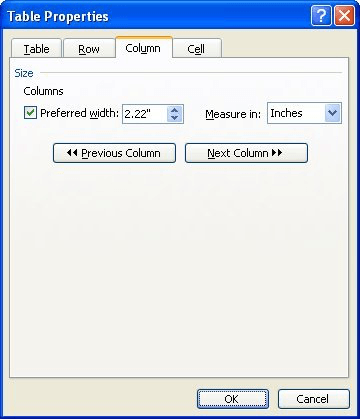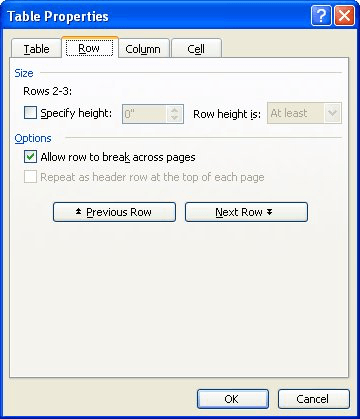Please Note: This article is written for users of the following Microsoft Word versions: 97, 2000, 2002, and 2003. If you are using a later version (Word 2007 or later), this tip may not work for you. For a version of this tip written specifically for later versions of Word, click here: Squaring Table Cells.
Written by Allen Wyatt (last updated December 23, 2023)
This tip applies to Word 97, 2000, 2002, and 2003
Tables can be very handy for organizing information in a document. Word provides the tools you need to create, edit, and format tables. In formatting a table, you may wonder about the best way to "square" all the cells in the table so that they are the same height and width. The answer depends on which version of Word you are using.
Follow these general steps if you are using Word 2000, Word 2002, or Word 2003:

Figure 1. The Column tab of the Table Properties dialog box.

Figure 2. The Row tab of the Table Properties dialog box.
If you are using Word 97, the steps are a bit different:
WordTips is your source for cost-effective Microsoft Word training. (Microsoft Word is the most popular word processing software in the world.) This tip (3890) applies to Microsoft Word 97, 2000, 2002, and 2003. You can find a version of this tip for the ribbon interface of Word (Word 2007 and later) here: Squaring Table Cells.

Create Custom Apps with VBA! Discover how to extend the capabilities of Office 365 applications with VBA programming. Written in clear terms and understandable language, the book includes systematic tutorials and contains both intermediate and advanced content for experienced VB developers. Designed to be comprehensive, the book addresses not just one Office application, but the entire Office suite. Check out Mastering VBA for Microsoft Office 365 today!
Easily add a blank line before your already inserted table.
Discover MoreOnce a table is inserted in your document, you can use the mouse to adjust the width of columns. The effect the mouse ...
Discover MoreTired of that old table taking up space in your document? You can get rid of it using a variety of techniques—some ...
Discover MoreFREE SERVICE: Get tips like this every week in WordTips, a free productivity newsletter. Enter your address and click "Subscribe."
There are currently no comments for this tip. (Be the first to leave your comment—just use the simple form above!)
Got a version of Word that uses the menu interface (Word 97, Word 2000, Word 2002, or Word 2003)? This site is for you! If you use a later version of Word, visit our WordTips site focusing on the ribbon interface.
Visit the WordTips channel on YouTube
FREE SERVICE: Get tips like this every week in WordTips, a free productivity newsletter. Enter your address and click "Subscribe."
Copyright © 2025 Sharon Parq Associates, Inc.
Comments